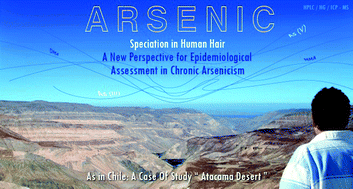The analysis for arsenic in hair is commonly used in epidemiological studies to assess exposure to this toxic element. However, poor correlation between total arsenic concentration in hair and water sources have been found in previous studies. Exclusive determination of endogenous arsenic in the hair, excluding external contamination has become an analytical challenge. Arsenic speciation in hair appears as a new possibility for analytical assessing in As-exposure studies. This study applied a relative simple method for arsenic speciation in human hair based on water extraction and HPLC-HG-ICP-MS. The concentration of arsenic species in human hair was assessed in chronically As(V)-exposed populations from two villages (Esquiña and Illapata) of the Atacama Desert, Chile. The arsenic concentrations in drinking water are 0.075 and 1.25 mg L−1, respectively, where As(V) represented between 92 and 99.5% of the total arsenic of the consumed waters. On average, the total arsenic concentrations in hair from individuals of Esquiña and Illapata were 0.7 and 6.1 μg g−1, respectively. Four arsenic species, As(III), DMA(V), MMA(V) and As(V), were detected and quantified in the hair extracts. Assuming the found species in extracts represent the species in hair, more than 98% of the total arsenic in hair corresponded to inorganic As. On average, As(III) concentrations in hair were 0.25 and 3.75 μg g−1 in Esquiña and Illapata, respectively; while, the As(V) average concentrations were 0.15 and 0.45 μg g−1 in Esquiña and Illapata, respectively. Methylated species represent less than 2% of the extracted As (DMA(V)
+ MMA(V)) in both populations. As(III) in hair shows the best correlation with chronic exposure to As(V) in comparison to other species and total arsenic. In fact, concentrations of As(total), As(III) and As(V) in hair samples are correlated with the age of the exposed individuals from Illapata (R
= 0.65, 0.69, 0.57, respectively) and with the time of residence in this village (R
= 0.54, 0.71 and 0.58, respectively).


 Please wait while we load your content...
Please wait while we load your content...